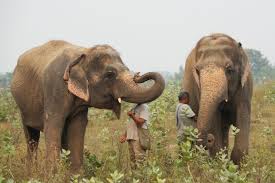The study of animal behavior is continually evolving, offering fresh insights into the complexities of the animal world. In 2024, researchers are unveiling surprising science facts about how animals interact with their environments, communicate, and adapt to challenges. This article explores some of the most intriguing discoveries in animal behavior, shedding light on the remarkable ways in which animals exhibit intelligence, emotion, and social structures.
1. Animals and Emotional Intelligence

1.1 Empathy in Elephants
Elephants have long been known for their impressive cognitive abilities, but recent studies have provided deeper insights into their emotional intelligence:
- Emotional Responses: Research in 2024 has shown that elephants exhibit empathy not just towards their kin but also towards other species. Observations reveal that elephants comfort distressed individuals and even help injured animals from different herds. For instance, elephants have been seen to stay close to dying companions, touching and gently nudging them as a form of support.
- Altruistic Behavior: Elephants display altruistic behavior by assisting other members of their group in accessing food and water, demonstrating a sophisticated understanding of group dynamics and individual needs.
1.2 Canine Emotional Awareness
Dogs have always been considered intuitive companions, but recent research highlights the depth of their emotional awareness:
- Human Emotions: Studies have shown that dogs can differentiate between human emotions and respond accordingly. For example, dogs are able to detect changes in human facial expressions and body language, adjusting their behavior to comfort or engage with their owners.
- Stress Detection: Dogs can also sense stress and anxiety in their human companions. Advanced research has revealed that dogs are capable of recognizing hormonal changes associated with stress and are more likely to exhibit comforting behaviors during these times.
2. Advanced Communication Techniques
2.1 The Complexity of Dolphin Language
Dolphins are renowned for their sophisticated communication skills, but 2024 research has uncovered even more about their language:
- Signature Whistles: Dolphins use a unique set of “signature whistles” that function like names, allowing individuals to identify and call each other. Recent studies have revealed that these whistles are more complex and varied than previously thought, indicating a high level of social interaction and individual recognition.
- Social Learning: Dolphins exhibit advanced social learning by mimicking the behaviors and sounds of other dolphins. This ability to learn through observation and imitation suggests a form of cultural transmission within dolphin pods.
2.2 Birdsong and Regional Dialects
Birdsong is a critical aspect of avian communication, and new findings in 2024 are expanding our understanding of its complexity:
- Regional Variations: Research has identified distinct regional dialects in various bird species. For instance, sparrows in different geographical areas have developed unique songs that are passed down through generations. These dialects help birds identify mates and establish territory.
- Song Learning: Birds learn their songs from older, experienced individuals in their communities. This process of song learning involves intricate social interactions and has implications for understanding avian social structures and behaviors.
3. Cognitive Abilities and Problem Solving
3.1 Tool Use in Octopuses
Octopuses have long fascinated scientists with their ability to use tools, and recent discoveries in 2024 have provided new insights:
- Complex Tool Use: Octopuses have been observed using coconut shells and discarded shells as shelters and tools. New studies reveal that these animals not only use tools but also exhibit planning and foresight in their use, suggesting a high level of cognitive function.
- Problem-Solving Skills: Octopuses demonstrate advanced problem-solving skills by solving puzzles to access food or escape enclosures. Their ability to manipulate objects and solve complex tasks highlights their remarkable intelligence.
3.2 Problem-Solving in Crows
Crows are known for their intelligence, and 2024 research has further demonstrated their problem-solving capabilities:
- Tool Innovation: Studies have shown that crows are capable of creating and using new tools to obtain food. For instance, crows have been observed bending wires into hooks to extract food from hard-to-reach places, showcasing their innovative problem-solving skills.
- Complex Cognitive Tasks: Crows can solve complex cognitive tasks that require planning and understanding of cause and effect. Experiments involving multiple steps and the use of tools have revealed that crows possess a level of cognitive flexibility previously thought to be unique to humans and great apes.
4. Social Structures and Behavior
4.1 Hierarchical Systems in Meerkats
Meerkats are known for their intricate social structures, and recent studies have unveiled new aspects of their behavior:
- Social Hierarchies: Meerkat societies are organized into complex hierarchies, with dominant individuals leading and coordinating group activities. Recent research has provided insights into how these hierarchies are maintained and the roles of various members in group dynamics.
- Cooperative Breeding: Meerkats exhibit cooperative breeding, where non-breeding members of the group help care for the offspring of the dominant pair. This behavior ensures the survival of the young and reinforces social bonds within the group.
4.2 Cooperation and Competition in Ants
Ants exhibit fascinating social behavior, and 2024 research has provided new insights into their cooperative and competitive strategies:
- Division of Labor: Ant colonies demonstrate a sophisticated division of labor, with different ants performing specialized tasks such as foraging, nest building, and brood care. Recent studies have explored how ants communicate and coordinate their activities to ensure colony success.
- Resource Competition: Ants engage in both cooperative and competitive behaviors when it comes to resources. Research has shown that ants can engage in competitive interactions with other colonies while simultaneously cooperating within their own colony to maximize resource acquisition.
5. Adaptations to Environmental Changes

5.1 Climate Change and Animal Migration
Climate change is impacting animal behavior, particularly in relation to migration patterns:
- Shifts in Migration Timing: Many species are adjusting their migration schedules in response to changing temperatures and weather patterns. For example, birds are migrating earlier in the spring and later in the fall, reflecting shifts in food availability and habitat conditions.
- Habitat Range Expansion: Some animals are expanding their ranges into new areas due to changing climate conditions. This expansion can lead to new interactions with other species and changes in local ecosystems.
5.2 Urban Adaptations in Wildlife
Wildlife is also adapting to urban environments, with surprising changes in behavior:
- Behavioral Flexibility: Urban wildlife, such as raccoons and pigeons, are exhibiting increased behavioral flexibility to thrive in city environments. Studies have shown that these animals are modifying their foraging habits and nesting behaviors to adapt to urban landscapes.
- Human-Wildlife Interactions: Urbanization has led to increased interactions between humans and wildlife. Research is focusing on how animals are adjusting their behaviors to coexist with human populations and the implications for both wildlife and human health.
Conclusion
The field of animal behavior is continually evolving, with 2024 bringing forth surprising and remarkable discoveries. From the emotional intelligence of elephants to the advanced problem-solving skills of crows and the adaptive behaviors of urban wildlife, these findings offer new insights into the complexities of the animal world. Understanding these behaviors not only enhances our knowledge of animal life but also underscores the importance of conserving habitats and fostering environments where wildlife can thrive. As research continues to uncover the secrets of animal behavior, it reminds us of the intricate and interconnected web of life that surrounds us.

